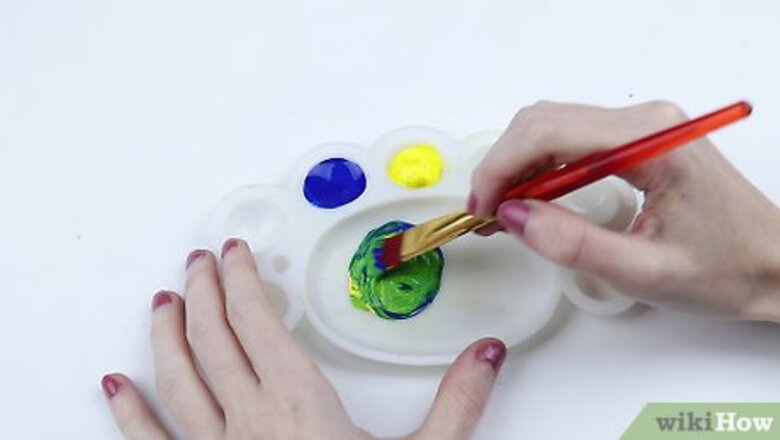
views
Making Green Paint
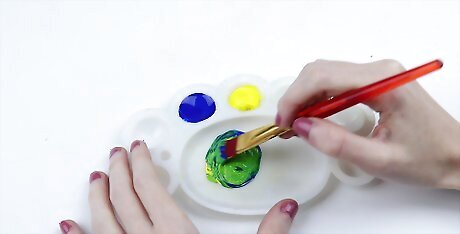
Blend together yellow and blue paint. Pour equal amounts of pure blue and pure yellow into a paint dish or onto a paint palette. Use a palette knife to thoroughly mix the colors together. When mixed, the original colors should produce a pure green. To get a more accurate idea of how this green looks, use a paint brush to apply a small amount to some scrap practice paper.
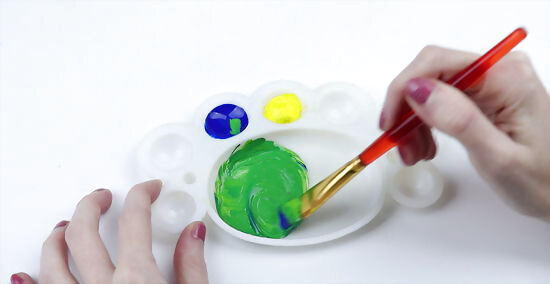
Vary the proportions. Depending on what you want to paint, pure green may not be the best green for your purposes. The simplest way to change the hue will be to add more yellow or more blue. Adding more yellow will create a warmer green, and adding more blue will produce a cooler green. When attempting to change the hue, make small changes until you find the hue you want. Gradually building the correct hue is easier and less wasteful than overcompensating and needing to work back toward the center from the extreme.
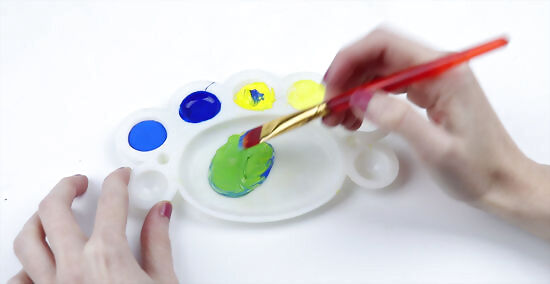
Experiment with different yellows and blues. Clear room on your palette and try mixing together several different hues of yellow and blue. Doing so should produce different hues of green. Pure yellow and pure blue will create pure green, but if these starting colors have been altered prior to being mixed, the resulting color will also change. For instance, combining golden yellow with a standard blue may result in a more muted, brownish green. On the other hand, mixing standard yellow with a light blue could produce a light green. The best way learn which blues and yellows produce which greens is through experimentation. Pick a few different hues of yellow and blue. Combine equal parts of one yellow and one blue hue, working through each possible combination. Mark down your results for future reference.
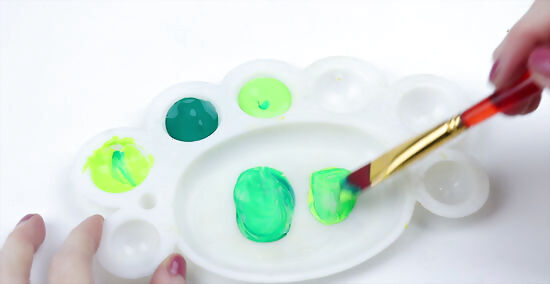
Try mixing different greens. If you have two hues of green that are close to the color you need but don't quite match it, you can try mixing the two hues together to achieve the desired color. Since all greens contain elements of blue and yellow, mixing them should result in new hues of green. You can also mix green together with different yellows or different blues to change the hue more dramatically.
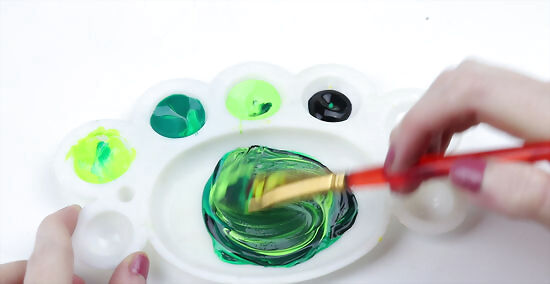
Change the value using black or white. Once you find the right hue, you can alter the value without changing the hue itself using black or white paint. They will make your green duller. Add white paint to create a lighter tint or black paint to create a darker shade. Regardless of which value you desire, you should add the white or black paint in small amounts. If you add too much, you can easily create a value that is far too light or far too dark.
Making Green Frosting

Set up several sample dishes. There's more than one way to create green icing, and there's also more than one hue of green you can create. Experimenting with several options at once will allow you to learn more about the process. You need at least four sample dishes, but the experiment will be more effective if you set up six to twelve dishes. Place 1/4 to 1/2 cup (60 to 125 ml) of white icing in each dish. Keep track of how much icing you use since it has an impact on the amount of food coloring you'll need. Obtain at least four food dye colors: one green, one yellow, one blue, and one black. You can also get other hues of green, yellow, or blue to experiment with. Paste, powder, and gel food dyes are designed for coloring frosting, so work with these types of dyes when possible since they should not alter the consistency of the frosting. Liquid dyes only work when you need very light tints; otherwise, the amount of liquid food coloring you'll need to create a vibrant hue will change the consistency of the frosting.
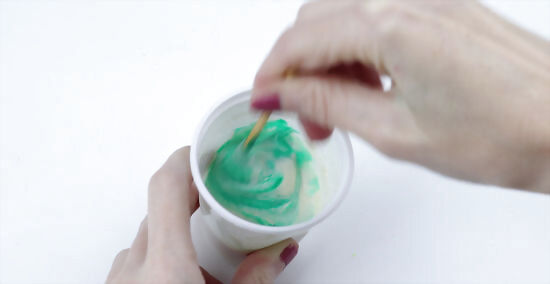
Add green food dye to one dish. Dip a toothpick into the green food coloring, then dunk the same toothpick into one dish of white frosting to transfer the dye. Mix until evenly blended. To get an accurate idea of the color you've created, you'll need to continue mixing until you can no longer see any remaining green streaks in the frosting. The type of green dye you use will affect the color of the icing. For instance, using "moss green" dye will create a warmer color than "kelly green" dye or "leaf green" dye. The amount of food coloring will affect the shade. Since the icing is white, using small amounts of green dye will produce very light, pastel greens. More dye will create more vibrant values.
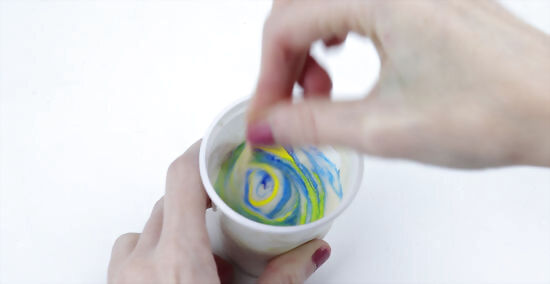
Mix equal parts of blue and yellow in another dish. Use separate, clean toothpicks to transfer equal parts of blue food dye and yellow food dye to the second dish of white icing. Mix until evenly combined. After mixing the blue and yellow food coloring, you should produce green frosting. The exact hue will vary based on the hues of yellow and blue you start with. Similarly, the value will vary based on how much food coloring you use.
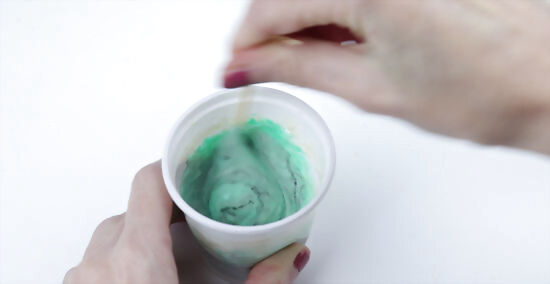
Combine green and black in another dish. Create a third dish of green icing by mixing in green dye or equal amounts of blue and yellow dyes, following the same procedure used for the other samples. Add a very small amount of black to this third sample. After thoroughly mixing in the black food coloring, you should see a darker shade of the original green. The actual hue should remain the same, though. Since black can have a dramatic impact on the appearance of the color, you should only work with very small amounts of it.
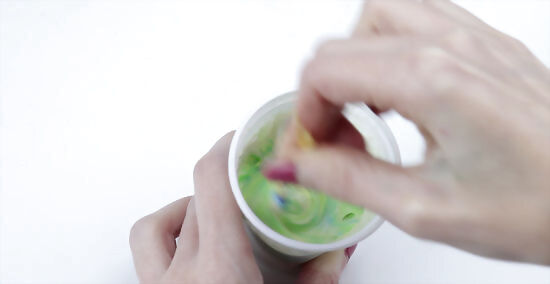
Experiment with other combinations. Use the remaining samples of white icing to experiment with different combinations. Record the dye hues and amounts used in each sample for later reference. Use guidelines from the dye manufacturer to create different hues or experiment on your own. Some ideas include: Mix equal parts sky blue and leaf green to create an aqua color. Create chartreuse using nine parts lemon yellow and one part leaf green. Combine equal parts leaf green and royal blue, then add a touch of black. This should create a deep jade color. Mix various amounts of lemon yellow and sky blue to produce a teal or turquoise color.
Making Green Polymer Clay
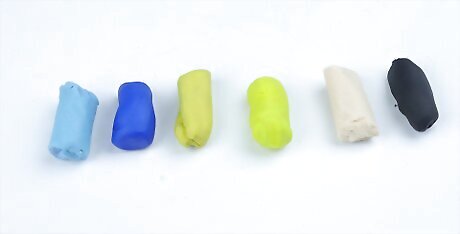
Gather several samples of clay. At minimum, you should have two blue clays, two yellow clays, one white clay, one transparent clay, and one black clay. One blue should be slightly warm (with a hint of green) while the other should be slightly cool (with a hint of purple). Similarly, one yellow should be slightly warm (with a hint of orange) and the other should be slightly cool (with a hint of green). You can use more variations of blue and yellow clay, but starting with two each should provide you with a fairly accurate understanding of how to make your desired hue of green.

Combine one blue clay with one yellow clay. Pinch off equal amounts of the warm blue and the cool yellow. Smash the two pieces together and knead the resulting ball until evenly blended. Roll, stretch, and knead the ball continuously to blend the colors. When finished, you should no longer see any streaks of blue or yellow in the sample. The finished color should be a relatively bright green since both the blue and yellow already leaned toward the color green.
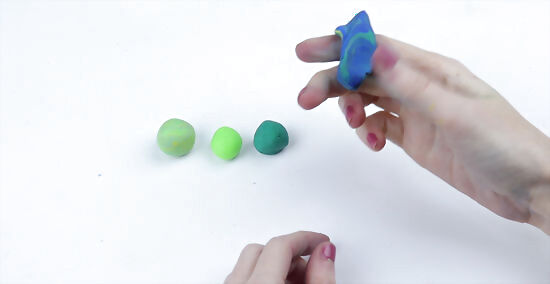
Work through the remaining combinations. Combine equal portions of the blue and yellow clays, following the same procedure used to create the first sample of green. Continue until you've worked through all possible combinations. The warm yellow and cool blue should create a dull green with hints of brown in it. The warm yellow and warm blue should create a medium-tone, warm green with strong yellow undertones. The cool yellow and cool blue should create a medium-tone, cool green with strong blue undertones.
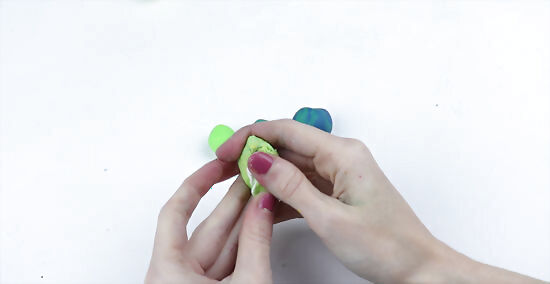
Add white to one sample. Pick your favorite green hue and duplicate the sample as before. After mixing the green, mix in a small pinch of white. Blend the white into the green until no streaks remain. The color should look less bright and should also gain a lighter tint. The more white you add, the lighter the tint will be.
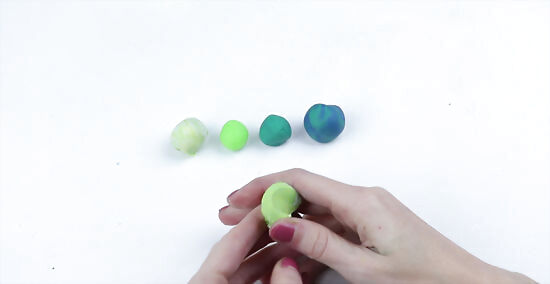
Add translucent clay to another sample. Duplicate the same green used in the previous sample, but do not add any white to it. Instead, mix in a small amount of translucent clay. Once blended, the translucent clay should make the green appear much less bright without changing the value or hue of the resulting sample. If you use more translucent clay than green, however, you'll end up with a semi-transparent wash of green instead of an opaque color.

Add black to a final sample. Create the same green used as the base in your white and translucent experiments. This time, thoroughly mix a very small pinch of black into the green. After blending the black into the green, the sample should develop a darker shade while remaining the same hue. In most cases, it won't take much black to dramatically darken the green, so you should only work in very small amounts.
Understanding Color Theory
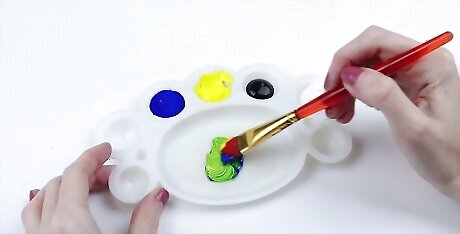
Mix yellow and blue. Green is a secondary color. To create it, you'll need to combine equal parts of blue and yellow, both of which are primary colors. "Primary" colors exist on their own and cannot be created by mixing other colors. The three primary colors are red, blue, and yellow, but you only need blue and yellow to create green. "Secondary" colors are colors obtained through the mixture of two primary colors. Green is a secondary color because it's made from blue and yellow. The other two secondary colors are orange and violet.
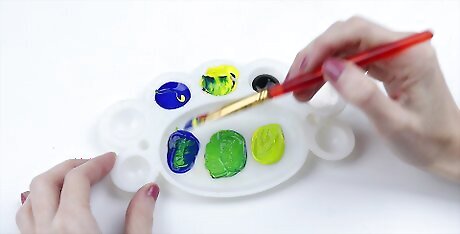
Vary the proportions to change the hue. Pure green is a mixture of pure yellow and pure blue, but if you add more blue or more yellow, you'll create a different slightly different hue of green. The two most basic variations are "blue green" and "yellow green," which are also referred to as "tertiary" colors since they fall between secondary and primary colors on the color wheel. Blue green is made with two parts blue and one part yellow. You could also create it by mixing equal parts of green and blue. Yellow green is made with two parts yellow and one part blue. You could also create it by mixing equal parts of green and yellow.
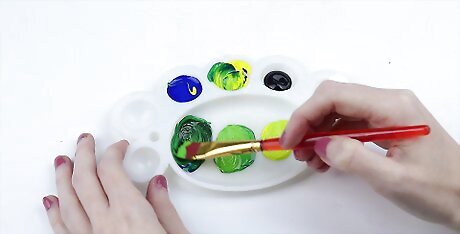
Change the value with black or white. If you want to lighten green without changing its hue, you'll need to add white. If you want to darken green, you need to add black. Light shades are referred to as "tints" and dark shades are called "shades."



















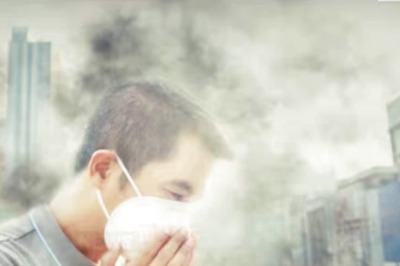
Comments
0 comment